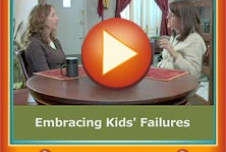Many of us know kids who seemed headed for disaster when they were young and in school. Maybe they flunked out of classes, or they did drugs, or they were depressed loners. But then something happened later and they blossomed into healthy, happy adults who contributed to society in important ways.
 This essay was adapted from Children Who Fail at School But Succeed at Life (W. W. Norton & Company, 2016, 304 pages)
This essay was adapted from Children Who Fail at School But Succeed at Life (W. W. Norton & Company, 2016, 304 pages)
How did they accomplish this? Researchers who study risk, resilience, and recovery throughout the lifespan have identified several ways that children move through adversity and find their way to thriving. Among the most important is the ability to see life’s setbacks and difficulties in a new light—to reframe them, if you will.
My experience in working with adults overcoming childhood traumas and setbacks has shown me—and research has confirmed—that the meaning we attach to adversity can determine whether we come to see ourselves as resilient and courageous, or helpless and hopeless.
But it’s not just what people tell themselves; it’s the meaning others attach to our adversities that can influence how we experience them, too. This is especially true for children who, as a result of their invisible neurodevelopmental, stress-related, or other challenges, learn and behave in paradoxically uneven ways. Too often, we can misinterpret the cause of this, which can lead to misunderstanding—and to well-intentioned but ineffective interventions.
In my new book, Children Who Fail at School But Succeed at Life, I highlight some of the misperceptions that can put these kids at further risk for failing at school. For example, many of us believe that those who do well in school are smart, while those who struggle in school are not. Many of us also equate resilience with success, ignoring specific learning challenges and important environmental influences. The truth is, some of smartest and most resilient people we will ever meet may struggle significantly just to get through a typical day, school-age children included.
When we succumb to these and other erroneous perceptions, we run the risk of prolonging school difficulties and preventing children from harnessing the resources they’ll need to succeed. I’ve worked a lot with adults who failed in school when they were younger, but ended up succeeding later in life—and they have taught me a lot about what it takes to get past these perceptions.
Here are nine ways educators can support kids so that fewer will succumb to problems these now-successful adults did decades ago. Some of these remedies focus on how to manage environmental risks, while others focus on managing neurodevelopmental risks; but it’s often a combination of these approaches that will be the most effective, especially in very risky, very averse situations.
1. Provide opportunities for kids to feel they belong and to contribute in meaningful ways.
To feel we belong and that we have something important to contribute are universal needs. Yet, some struggling children don’t experience either of these until they’ve reach adulthood. One way to prevent this is to provide kids with important jobs and responsibilities that teachers and others value. Maybe a kid who talks a lot would be a great student ambassador for their school, or a child who’s very artistic can create a mural for the classroom. Perhaps an older child can become a tutor for a younger child, or a child who has trouble sitting still can be responsible for delivering messages between classrooms. Giving kids responsibilities like these can go a long way in helping them feel they belong and have something important to contribute to others and to their community.
2. Raise the bar and level the playing field.
Many of those who failed at school remember the well-intentioned adults who tried to help them. But they also remember how some of that help drew unwanted attention to challenges they viewed as shameful and embarrassing. Many eventually stopped accepting help as a result. While it’s important to level the playing field by offering support to kids, it’s also important to raise the bar for them concurrently. This begins by helping them see their challenges in a new light. Programs like Eye-to-Eye and WhyTry move kids along this path. Eye-to-Eye pairs trained college and high school mentors succeeding in spite of learning differences with younger students experiencing the very same differences. WhyTry provides a series of lessons and experiential activities that help struggling students learn to reframe and rise above personal and school-related challenges.
3. Don’t expect a child to succeed in isolation.
Wrap-around services for communities in need can help provide the kinds of supports kids need to do well in school, especially in high-risk neighborhoods. Restorative justice programs, which move schools away from a zero-tolerance, punative approach to a more educative process where children take responsibility for their actions and make amends, have been shown to build trust among and between students, teachers, and others in the school community. Other programs, like Peacebuilders and the Heroic Imagination Project, when adopted by schools, give kids the message that they can make a difference in creating a school where kindness is practiced and children are safe from bullying. Programs like these help change a whole school climate and can be important for kids who are struggling and otherwise feel ostracized.
4. Reward struggle as well as achievement.
It’s easy to say, but so difficult to do this, because we are trained to evaluate children based on their successes. But Carol Dweck and others point to the importance of fostering a growth mindset, in which kids are praised for their efforts more than their achievements, allowing for and even encouraging mistakes. Some teachers go so far as to reward kids for sharing their struggles, which gives kids the message that everyone struggles and that “being smart” is not a fixed trait delegated to the few. It can also help to teach kids the science behind this—the plasticity of the brain and the way that memory works—through programs like Brainology, which make it fun and interactive.
5. Be a talent scout.
The opportunity to do what we love to do and do well can reveal personal strengths and qualities that may have otherwise gone unnoticed. Find children’s unique strengths and talents, then highlight and celebrate them. Howard Gardner’s Frames of Mind: The Theory of Multiple Intelligences can be a helpful resource. Gardner identified eight different areas of intellectual capacity—spatial, musical, bodily kinesthetic, interpersonal, intrapersonal, naturalistic, linguistic, and logical-mathematical. School focuses a great deal on the last two. Don’t forget that kids may be gifted in other areas and steer them toward developing these skills further, in school and out of it.
6. Consider a change of scenery or change the school social climate.
Sometimes moving to a new classroom or attending a different school can make a big difference for struggling students and give them the message that failure is not all about them. Studies have shown that relocating to a neighborhood where parents watch over kids—and where new peer influences replace disruptive ones—improves a student’s chances to succeed.
But, for those who can’t simply move to a new classroom, a new school, or new neighborhood, changing the school’s social climate can help, too. Research has shown that during earlier grades interventions like The PAX Good Behavior Game, which provides students immediate rewards for good behavior and encourages peers to root for each other, can improve classroom management and make a big difference in how students do in school as well as how they adjust years later. In my book, I discuss a number of other effective school-based models and interventions, such as Jigsaw, Positive Interventions and Supports, Not in Our School, and project-based learning.
7. Encourage kids to speak out and get involved.
In a culture that stigmatizes those who struggle with learning, behavioral, or emotional challenges, some people still rise above them. They find the courage to tackle these challenges head on, and they work hard to succeed in spite of them. Some take it a step further, though, and speak out against that stigmatization, empowering themselves and others. Programs like Active Minds or LETS (Let’s Erase the Stigma) encourage students who suffer from mental health or other challenges to share their stories or to mentor younger children. This helps them find meaning in their suffering, by helping other struggling students to avoid feelings of isolation and giving them a new sense of themselves as resilient survivors.
8. Never underestimate the positive impact you can have on a struggling child’s later life course.
Predicting with absolute certainty what will become of us in the future based upon what may have happened to us in the past is simply impossible. One reason is that lives can change in very significant ways in response to entirely unpredictable and unanticipated experiences. Researchers who study resilience through the lifespan refer to these experiences as turning points. And while they may not realize it, every day teachers and other caring individuals at school are providing struggling children with experiences that years or decades later may be viewed by these students as turning points. Some teachers are creating the meaningful roles I mentioned above, while others are taking the time to send e-mails, text messages, or letters to parents each week celebrating their child’s accomplishments. Some allow students disadvantaged by virtue of their challenges to demonstrate mastery of a subject in ways they learn and communicate best; others are coaching students on new educational technologies or tutoring them after school to help level the academic playing field. Teachers are experts at finding creative ways to help their students shine, and when they do, they’re opening the door to potential turning points in the lives of struggling children.
9. Use caution when judging who is and who is not resilient.
Resilient people—school-age children included—think and act differently in places they find threatening and dangerous as opposed to places they find warm and friendly, particularly when those threatening and dangerous places also feel stigmatizing, inescapable, and beyond their ability to control or influence. To really appreciate human resilience, therefore, one needs to also appreciate the role that contextual influences can play in determining who rises above adverse childhood experiences and who succumbs. This is not always easy, as research suggests that we’re more likely to appreciate contextual influences when making sense of our own behavior, rather than the behavior of others. But it’s critical that we try if we want to help kids succeed.
Children who fail at school but succeed at life have a lot to teach us. While we tend to focus on the strengths and qualities of those who do well in school—in an effort to help those who fail be more like them—I would argue that we should champion those who during their childhood years were stretched beyond their limits of emotional endurance, then managed to overcome adversity and go on to lead meaningful and productive lives. These people can provide us with new remedies, ones that can potentially prevent serious learning, behavioral, and emotional problems, reduce juvenile crime, school dropout, and substance abuse, and increase human productivity at work and in life.
More details, including the research that supports these interventions, can be found in my book.







Comments